The family name Menzies is pronounced "Mengus".
This condensed life story is compiled from
"The Family history" as written by John Menzies himself (FHM),
"The recollections of Frances Menzies" (his wife, complied
by Janet Hogden (FMR),
the Edwin Stanford memoirs (EMS),
a web-text by Janet Hogden
and further public information from the internet.
John Henry Menzies was born in 1839 in Liverpool
of scottish descent.
After John had left school in Liverpool
he spent a year at Edinburgh University followed by
an unsuccessful period as an insurance clerk in the firm of
Jones, Palmer, and Co., in Liverpool.
During this phase he enjoyed outdoor activities -botany field trips,
walking tours with his brothers around Liverpool and Ireland-
and was taken on a tour of Europe by his father.
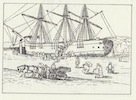
|
Before he sailed, he spent a period with a well-to-do farmer in Yorkshire, near his mother's family, who also had a business as a tenant right valuer. Going round various sorts of land with the shrewd Mr Simpson gave young John Henry a good preparation for his land purchase and development activities in New Zealand.

|
He left from Bristol on a wooden ship, the Motueka, and made a drawing of it (FHM p.77). After 88 days without a stop he arrived in Lyttelton (NZ) in December 1860. The harbour engraving (at left) is from 1863.
|
Map of the NW part of Banks Peninsula. L= Lyttelton, P= Purau, M= the Monument. MMB= Mackintosh Menzies Bay. |

|
With a companion (Fenn Dunn) he set out for Akaroa. They crossed Lyttelton Harbour by ferry, to Purau, climbed up along the notable mountain "The Monument", and then travelled over the bush overgrown Banks Peninsula (Maori name Horomaka) via Summit Road, which had just been cut, to Akaroa, to see someone they had been recommended to visit. Then they returned and went to Christchurch.
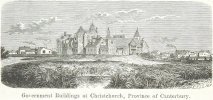
|

|

|
Frances, whose father William was a medical doctor, grew up in Guildford. In Guildford the family had moved at least 3 times. Following her own description (Recollections of Frances Menzies; FMR), Frances had brown eyes, dark brown hair, nearly black, rather curly.
An uncle of Frances, Edward Butler, had gone to New Zealand and later her father decided to emigrate as well. The family settled with uncle Edward at Ryal Bush, a little north of Invercargill, in 1862. Her father William now turned to farming.
In 1865 John Menzies married Frances Elizabeth Butler.
Children in Southland: in Spar Bush: 1866 Mary(+1893), 1868 Alice (painted roses; invalid later in life), 1869 Henry(+1883), 1870 William/Willie (x Gertrude Thorpe),

|
In 1872 John and Frances moved to Riverton. In 1874 they bought a 4000 acre property near Otautau north of Riverton/Aparima on the left bank of the river Aparima. They called the farm Ringway after the Menzies family farm in England. The drawing by JHM shows how the farm was situated (FHM p.133). The name Ringway still exists near Otautau.
In 1878, they decided to move further north (to a better climate), to be free of rabbits,
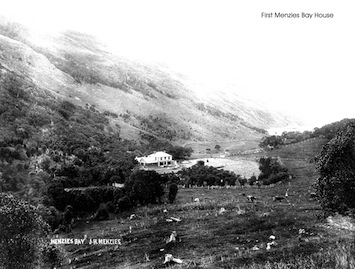
|
Children at Menzies Bay: 1880 Constance (x Francis Thorpe), 1881 Norman (x Leeta Thorpe), 1883 Elsie (artistic; helped all family, stayed single).
John and Frances also owned a house in Christchurch in Hereford street, near the Elmo flats. Francis lived there with the school-going children. There was quite a bit of ground and large stables with it (see ESM). During school vacations all came home to the homestead in Menzies Bay.
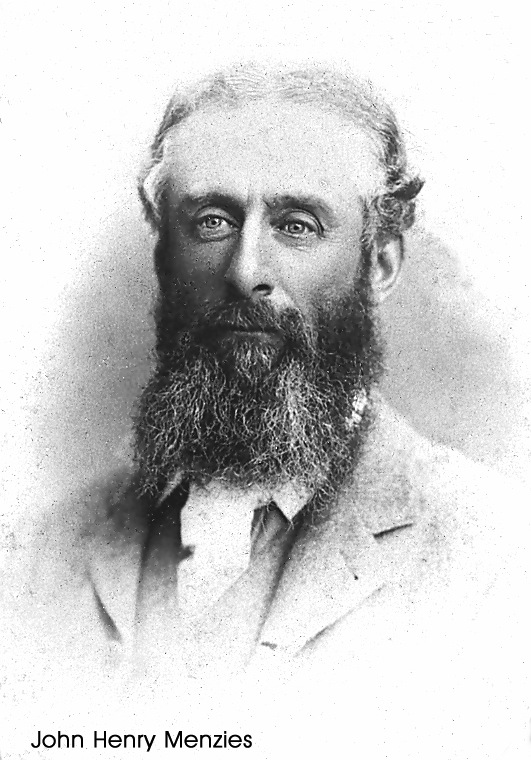
|
John must have been a bit eccentric. He never shaved. His son in law, Edwin Stanford writes in his memoirs (EMS): Mr Menzies had his own water tank, from which only he drank. He was feddy about his food - he ate large quantities of bread without butter or anything, but dipped in a large pile of salt on the table cloth beside his plate. .... He had spells of certain things - sometimes it was raw eggs, in which he knocked a hole at each end, tipped up in the air and sucked dry. If eggs were scarce I was sent on horseback to scour the other Bays for eggs. If none at Pigeon Bay then off in the afternoon on a fresh horse to Litlle Akaloa. Another time the creek would have to be hunted up stream and down for fresh water cress for every meal. .... His favourite medicine was sulphur, of which he ate large quantities and carried it about with him in paper in his pockets. The consequence was, all his silver money became discoloured, and tram guards and people could not tell his shillings from halfpennies. He also chewed large quantities of turkey rhubarb.
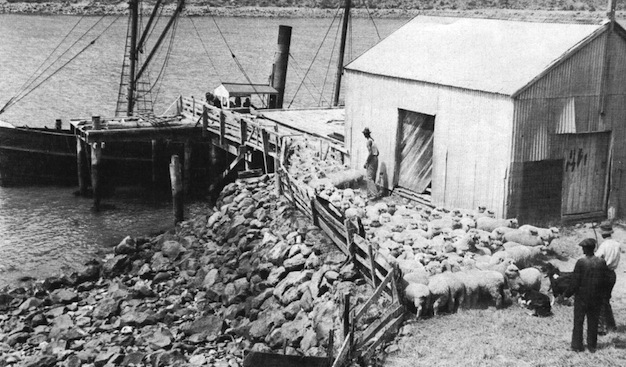
|
The farm had mostly sheep, but also a cow for milk, etc. Sheep were mostly sold at the large markets. For that they literally had to be shipped (see photo taken in the 1930s; from FMR). Menzies Bay was in the 19th century and up into the 20th century best reached by ships, that served many bays along Banks Peninsula.
When the sons and daughters became adults, John Henry managed to find (and buy) farms for them (or parts thereof). In this way, William (with Gertrude Thorpe) was set up in Menzies Bay, too, Stephen at Little Akaloa (Glen-Weem), Constance and Francis Thorpe near Menzies Bay (at Outwood), Charlotte and husband Edwin near Waikari, etc.
The names of the farms John Henry initiated hark back to names from his past: Weem is the name of land being part of the Menzies Castle estate in Scotland. Ringway (founded in 1872, see above) and Outwood are the short forms of Ringway-Outwood, the name of the farm John Henry's father had near Liverpool.
In 1899 John had a problem with his knee
and went to see a specialist in England.
In 1906 John Henry engages himself in building a new church in Little Akaloa.
He carves the wood as well as several stones for that building himself,
with Maori patterns (see JHM and woodwork).
In 1908 the old homestead at the bay burned down.
Frances and the younger girls were at that time in Christchurch
in the rented house at Hawkesbury Avenue.
John set out to build a new house.
Frances died in July 1908
and was buried at the Bay cemetery 18 July 1908.
John continued to live at the Bay.
But then he sold his property to sons and neighbours (see ESM)
and bought 1000 acres of tussoc hill, Glenn-Lyon,
between Halswell and Tai-Tapu
bordering the Sir Rhodes' Otahuna estate (see OSM).
He also bought a Model 1911 T-Ford.
Thereafter, he lived with his two daughters Alice (who needed help)
and Elsie (who helped all family in times of need),
at 44 Knowles Street in Christchurch.
John Henry Menzies died in 1919.
On 13 February 1919 the newspaper Christchurch Star wrote:
John Henry Menzies, of Menzie's Bay, Banks Peninsula,
died on 12 Feb at 87 Cashmere rd, in his 80th year. was born in Cheshire
-- came to NZ age 22 in the Motueka, landing at Southland --
liberally contributed to the stone church at Little Akaloa,
he designed the building and did the carving for the interior,
for the font and the desk.
he leaves 3 married sons, 2 married daughters, and 2 unmarried daughters,
Mrs Menzies died about 10 years ago.
the body will be taken to Lyttelton this morning and the funeral
will take place at Menzie's Bay Cemetery at 3pm.
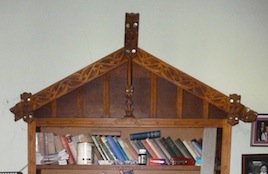
|
A bookcase with at the top Maori-like carvings was inherited by descendants. The photo of this bookcase shows (at right) a support needed after the Feb. 2011 earthquake.
FHM: "Family History" by J.H.Menzies (*1840),
illustrated with numerous drawings by himself.
The book gives the ancestry and history up to 1877.
Republished in 2003, ISBN 1-877242-26-8
FMR: "The recollections of Frances Elizabeth Menzies", ISBN
1-877212-27-6
ESM: Edwin Stanford's Memoirs to about 1915;
in Jacometti-Stanford archive.
OSM: Owen Stanfords memoir: "I well remember"; in
Jacometti-Stanford archive.
Images: The first 4 photos are taken from FMR, the drawings from FHM.
The drawing of the Christchurch government buildings is from:
Hochstetter, F. von, 1864, "Geologie von Neuseeland.
Beiträge zur Geologie der Provinzen Auckland und Nelson";
Wien 1864. Translated into english and published in 1895 as
"New Zealand - Its Physical Geography, Geology and Natural History,
with Special Reference to the Provinces of Auckland and Nelson".
To the enlarged images.
Back to the genealogy of JHM and FEB.